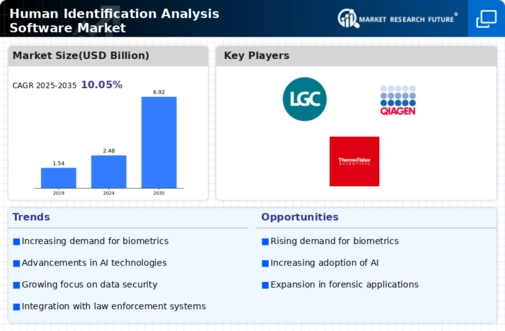Market Growth Projections
The Global Human Identification Analysis Software Market Industry is on a trajectory of substantial growth, with projections indicating a rise from 2.48 USD Billion in 2024 to 6.92 USD Billion by 2035. This growth is underpinned by a compound annual growth rate (CAGR) of 9.77% from 2025 to 2035. The increasing integration of biometric technologies across various sectors, coupled with the growing need for enhanced security measures, suggests a robust demand for human identification analysis software. This upward trend reflects the industry's adaptability to evolving security challenges and technological advancements, positioning it for continued expansion in the coming years.
Rising Cybersecurity Threats
The Global Human Identification Analysis Software Market Industry is increasingly shaped by the rising threats posed by cybercrime and identity theft. As organizations face heightened risks, there is a growing emphasis on implementing robust identification solutions to protect sensitive data and maintain user trust. Biometric authentication methods are being recognized for their effectiveness in mitigating these threats, leading to a surge in adoption across various sectors. This trend is expected to contribute to the market's growth, with projections indicating an increase from 2.48 USD Billion in 2024 to 6.92 USD Billion by 2035. The focus on cybersecurity is likely to drive further innovations in identification technologies.
Regulatory Compliance and Standards
The Global Human Identification Analysis Software Market Industry is significantly influenced by the need for regulatory compliance and adherence to standards. Governments and regulatory bodies worldwide are increasingly mandating the use of identification technologies to enhance security and streamline processes. This regulatory landscape compels organizations to adopt human identification analysis software to meet compliance requirements. As a result, the market is poised for growth, with estimates suggesting an increase from 2.48 USD Billion in 2024 to 6.92 USD Billion by 2035. The emphasis on compliance not only drives demand but also fosters innovation in the development of reliable identification solutions.
Growing Adoption in Healthcare Sector
The healthcare sector is emerging as a key driver for the Global Human Identification Analysis Software Market Industry. With the increasing need for accurate patient identification and data management, healthcare providers are adopting advanced identification technologies to enhance patient safety and streamline operations. Biometric systems facilitate secure access to patient records, thereby reducing errors and improving overall healthcare delivery. The market is projected to grow from 2.48 USD Billion in 2024 to 6.92 USD Billion by 2035, highlighting the sector's pivotal role in driving demand for human identification analysis software. This trend reflects a broader commitment to leveraging technology for improved healthcare outcomes.
Increasing Demand for Security Solutions
The Global Human Identification Analysis Software Market Industry is experiencing a surge in demand for advanced security solutions. This trend is driven by rising concerns over personal safety and the need for enhanced security measures across various sectors, including law enforcement, healthcare, and corporate environments. As organizations increasingly adopt biometric technologies, the market is projected to grow from 2.48 USD Billion in 2024 to an estimated 6.92 USD Billion by 2035, reflecting a compound annual growth rate (CAGR) of 9.77% from 2025 to 2035. This growth indicates a robust shift towards integrating sophisticated identification systems to mitigate security risks.
Technological Advancements in Biometric Systems
Technological innovations play a pivotal role in shaping the Global Human Identification Analysis Software Market Industry. The advent of sophisticated biometric systems, such as facial recognition, fingerprint scanning, and iris recognition, has revolutionized identification processes. These advancements not only enhance accuracy but also improve the speed of identification, making them indispensable in various applications. As organizations seek to leverage these technologies, the market is expected to witness substantial growth, with projections indicating a rise from 2.48 USD Billion in 2024 to 6.92 USD Billion by 2035. This trend underscores the importance of continuous innovation in driving market expansion.






Leave a Comment